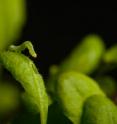Plants use circadian rhythms to prepare for battle with insects
In a study of the molecular underpinnings of plants' pest resistance, Rice University biologists have shown that plants both anticipate daytime raids by hungry insects and make sophisticated preparations to fend them off. "When you walk past plants, they don't look like they're doing anything," said Janet Braam, an investigator on the new study, which appears this week in the Proceedings of the National Academy of Sciences. "It's intriguing to see all of this activity down at the genetic level. It's like watching a besieged fortress go on full alert."
Braam, professor and chair of Rice's Department of Biochemistry and Cell Biology, said scientists have long known that plants have an internal clock that allows them to measure time regardless of light conditions. For example, some plants that track the sun with their leaves during the day are known to "reset" their leaves at night and move them back toward the east in anticipation of sunrise.
In recent years, scientists have begun to apply powerful genetic tools to the study of plant circadian rhythms. Researchers have found that as many as one-third of the genes in Arabidopsis thaliana -- a widely studied species in plant biology -- are activated by the circadian cycle. Rice biochemist Michael Covington found that some of these circadian-regulated genes were also connected to wounding responses.
"We wondered whether some of these circadian-regulated genes might allow plants to anticipate attacks from insects, in much the same way that they anticipate the sunrise," said Covington, now at the University of California, Davis.
Danielle Goodspeed, a graduate student in biochemistry and cell biology, designed a clever experiment to answer the question. She used 12-hour light cycles to entrain the circadian clocks of both Arabidopsis plants and cabbage loopers, a type of caterpillar that eats Arabidopsis. Half of the plants were placed with caterpillars on a regular day-night cycle, and the other half were placed with "out-of-phase" caterpillars whose internal clocks were set to daytime mode during the hours that the plants were in nighttime mode.
"We found that the plants whose clocks were in phase with the insects were relatively resistant, whereas the plants whose clocks were out of phase were decimated by the insects feeding on them," Goodspeed said.
Wassim Chehab, a Rice faculty fellow in biochemistry and cell biology, helped Goodspeed design a follow-up experiment to understand how plants used their internal clocks to resist insect attacks. Chehab and Goodspeed examined the accumulation of the hormone jasmonate, which plants use to regulate the production of metabolites that interfere with insect digestion.
They found that Arabidopsis uses its circadian clock to increase jasmonate production during the day, when insects like cabbage loopers feed the most. They also found that the plants used their internal clocks to regulate the production of other chemical defenses, including those that protect against bacterial infections.
"Jasmonate defenses are employed by virtually all plants, including tomatoes, rice and corn," Chehab said. "Understanding how plants regulate these hormones could be important for understanding why some pests are more damaging than others, and it could help suggest new strategies for insect resistance."
The research was supported by the National Science Foundation and Rice University. Additional co-authors include Rice undergraduate Amelia Min-Venditti.
Source: Rice University
Other sources
- Plants use internal clock for defensefrom UPITue, 14 Feb 2012, 23:30:38 UTC
- Plants use internal clock for defensefrom UPITue, 14 Feb 2012, 22:30:34 UTC
- Plants use circadian rhythms to prepare for battle with insectsfrom Science DailyTue, 14 Feb 2012, 2:30:18 UTC
- Plants use circadian rhythms to prepare for battle with insectsfrom PhysorgMon, 13 Feb 2012, 22:30:44 UTC

